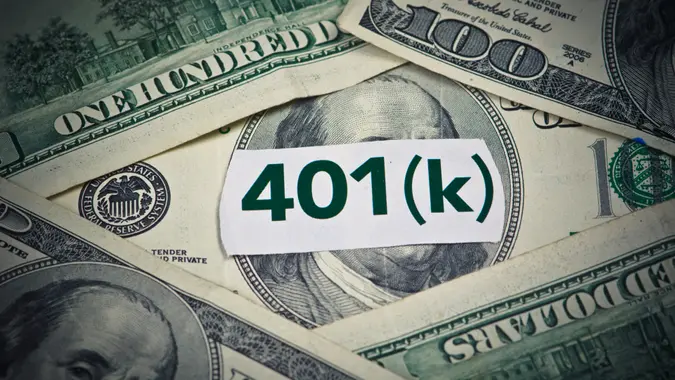The 10 Best States To Retire at 40 That Don’t Require You To Be a Millionaire

Commitment to Our Readers
GOBankingRates' editorial team is committed to bringing you unbiased reviews and information. We use data-driven methodologies to evaluate financial products and services - our reviews and ratings are not influenced by advertisers. You can read more about our editorial guidelines and our products and services review methodology.

20 Years
Helping You Live Richer

Reviewed
by Experts

Trusted by
Millions of Readers
Many Americans dream of living the retirement lifestyle. They may envision lives full of travel and enjoying drinks with tiny umbrellas on secluded beaches. Early retirement flips the mentality of working for decades in an office, with fewer years to enjoy life. The financial independence, retire early (FIRE) movement epitomizes that desire through aggressive investing to enable aspirants to retire as early as 40 years old.
FIRE devotees often use the 4% rule to determine if they can retire early. The rule is simple: You add all your investments together and withdraw 4% of the total in your first year of retirement. That amount is adjusted for inflation in the following years and assumes the likelihood of not outliving your resources for the following three decades.
Additionally, early retirement requires increasingly purposeful spending and saving in early years to achieve the goal. Retiring at 40 is seemingly impossible, but it’s achievable with purposeful actions, notably finding a low-cost-of-living place to live.
A recent study from Falcon Funded reveals the best states to retire at 40, and none of them require millionaire status. The study looks at monthly cost of living for one person without rent, average monthly rent for a one-bedroom apartment, annual healthcare costs and annual cost of living with rent. The annual amount was multiplied by 25 to determine the required retirement savings.
Also find out how much you need to save monthly to retire comfortably in every state.
Mississippi
- Monthly cost of living per person (without rent): $807
- Average monthly rent (one bedroom): $973
- Annual healthcare cost: $9,394
- Annual cost of living with rent: $30,754
- 4% rule for withdrawals: $768,850
Iowa
- Monthly cost of living per person (without rent): $863
- Average monthly rent (one bedroom): $955
- Annual healthcare cost: $9,789
- Annual cost of living with rent: $31,605
- 4% rule for withdrawals: $790,125
Kansas
- Monthly cost of living per person (without rent): $1,138
- Average monthly rent (one bedroom): $943
- Annual healthcare cost: $9,408
- Annual cost of living with rent: $34,369
- 4% rule for withdrawals: $859,230
New Mexico
- Monthly cost of living per person (without rent): $1,047
- Average monthly rent (one bedroom): $1,139
- Annual healthcare cost: $8,902
- Annual cost of living with rent: $35,132
- 4% rule for withdrawals: $878,305
Oklahoma
- Monthly cost of living per person (without rent): $1,146
- Average monthly rent (one bedroom): $1,010
- Annual healthcare cost: $9,444
- Annual cost of living with rent: $35,318
- 4% rule for withdrawals: $882,960
North Dakota
- Monthly cost of living per person (without rent): $1,087
- Average monthly rent (one bedroom): $935
- Annual healthcare cost: $11,301
- Annual cost of living with rent: $35,566
- 4% rule for withdrawals: $889,158
West Virginia
- Monthly cost of living per person (without rent): $990
- Average monthly rent (one bedroom): $914
- Annual healthcare cost: $12,769
- Annual cost of living with rent: $35,612
- 4% rule for withdrawals: $890,308
South Dakota
- Monthly cost of living per person (without rent): $1,095
- Average monthly rent (one bedroom): $974
- Annual healthcare cost: $12,495
- Annual cost of living with rent: $37,328
- 4% rule for withdrawals: $933,201
Alabama
- Monthly cost of living per person (without rent): $1,162
- Average monthly rent (one bedroom): $1,200
- Annual healthcare cost: $9,280
- Annual cost of living with rent: $37,628
- 4% rule for withdrawals: $940,690
Arkansas
- Monthly cost of living per person (without rent): $1,083
- Average monthly rent (one bedroom): $1,276
- Annual healthcare cost: $9,338
- Annual cost of living with rent: $37,639
- 4% rule for withdrawals: $940,970
The Bottom Line
Risks aside, retiring at 40 is possible with committed action.
“A person aiming to retire at 40 needs to think far beyond lifestyle goals — they need to think geographically. Housing remains the biggest driver, but healthcare and quality of life metrics also shift the savings target dramatically from state to state,” said Nathan Nolan, a spokesperson from Falcon Funded. “Even small differences in monthly expenses can add up to hundreds of thousands in retirement savings over time.”
Before beginning a journey towards early retirement, analyze the risks to create a plan to guide your decisions.
 Written by
Written by  Edited by
Edited by 

























